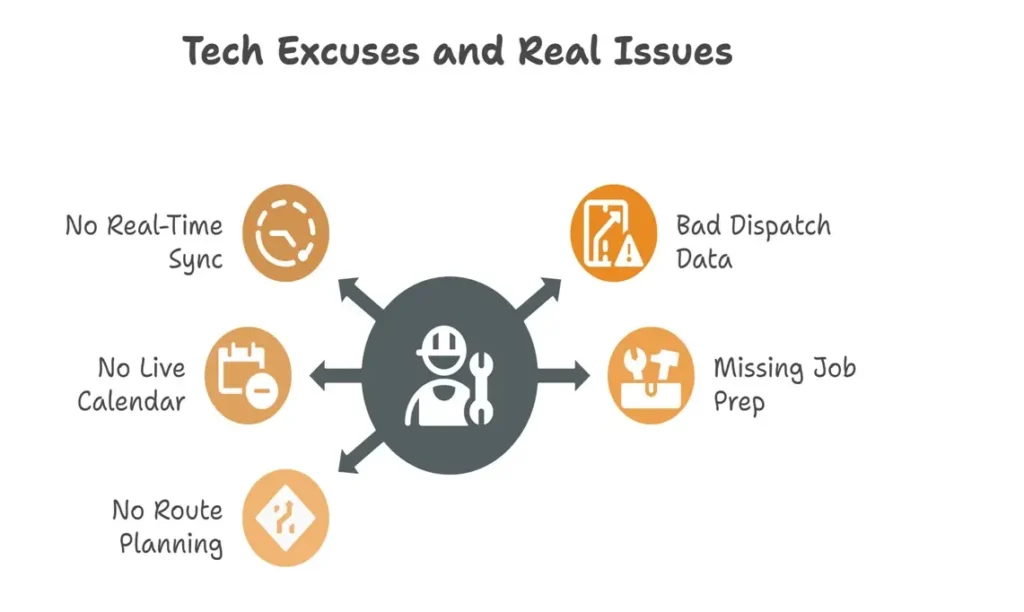Let’s be real, if your Field team schedule’s a mess, your whole day’s a mess. Ask anyone running a field service crew, and they’ll tell you the same thing: bad scheduling doesn’t just slow things down, it hits you where it hurts, your bottom line.
I’ve been in the trenches with techs who show up at the wrong site, show up late, or get double-booked because the dispatch board looked like someone shook a snow globe. And when that happens? You get missed jobs, angry customers, and guys just sitting in their vans twiddling their thumbs when they could be working.
Why Scheduling Breaks Down
The classic culprits
You don’t need a Harvard MBA to see what throws a wrench in scheduling. It’s often the basics:
- Paper-based job orders getting lost or smudged
- Dispatcher scrambling between calls and texts
- Techs who forget to check their assignments
- No clear view of who’s where and when
One HVAC buddy of mine once told me how a broken A/C in the middle of July was assigned to two techs, both showed up, both confused, and meanwhile, another customer’s house felt like a sauna because no one showed up there.
Growth brings chaos
When your team grows, and you’re booking more jobs, the problems multiply. Suddenly, you’re not just managing two trucks, you’ve got five, maybe ten, and you’re juggling maintenance jobs, emergency calls, and installs all at once. That kind of pressure exposes every crack in your system.

What It’s Really Costing You
Lost revenue
Every missed appointment? That’s money down the drain. The average service call in the U.S. can range from $150 to $300. Miss a few, and you’re talking thousands a month. And those missed jobs? They don’t always come back.
Burnout and frustration
Your techs signed up to fix stuff, not play phone tag or sit in traffic rerouted three times. Poor scheduling means more idle time, more back-and-forth, and a lot more grumbling. Keep that up, and you’re gonna lose good people.
Bad customer reviews
People are quick to leave a 1-star review when no one shows up. And these days, one bad Google review can cost you more than you think. According to BrightLocal, 98% of people read online reviews for local businesses, and 57% won’t even consider a business with fewer than 4 stars.
The Long-Term Risk
1) You stop growing
Poor scheduling becomes a bottleneck. Even if your marketing’s working and the phone’s ringing off the hook, if you can’t keep up with demand, you’ll stall out. And worse? You might get a reputation for being unreliable.
2) Your reputation takes a hit
In the field world, reputation is everything. Folks talk. A homeowner with a bad experience will tell ten friends. A property manager might move all their contracts to a competitor who shows up on time.
What Future Trends Say
Field service is going digital, and fast. According to a report by MarketsandMarkets, the field service management market is expected to grow from $3.6 billion in 2020 to $10.3 billion by 2026. That’s a big jump, and it’s being driven by one thing: smarter tools that make life easier for crews and dispatchers.
How to Turn It Around
1. Get visibility
You can’t fix what you can’t see. Use tools that let you track jobs, locations, and availability in real-time. Know where your people are. Know when a job’s running long.
2. Set realistic time windows
Stop stacking jobs like Tetris. Build in buffer time. Respect traffic patterns. If a job usually takes an hour, don’t pretend it’ll be done in 45 just to squeeze another one in.
3. Use software that’s built for your crew
That’s where something like Field Promax fits in. It’s not some bloated tool built for corporate guys in suits, it’s made for folks in the field. With easy dispatching, live GPS tracking, and mobile access for techs, it helps teams stay on track without the back-and-forth. And the best part? It actually makes your life easier instead of adding more to your plate.

Why Authenticity in Content (and Work) Still Wins
Let’s shift gears for a second.
Whether you’re fixing pipes, wiring a new breaker, or writing a blog post like this one, people want the real deal. Not polished fluff. Not buzzwords. Just honest value.
1) What AI Gets Wrong
AI can churn out a decent paragraph. Heck, it might even get close to what you’re looking for. But when it comes to sounding real, like someone who’s actually done the work or lived the story, it falls short. Customers, readers, heck, even algorithms, are starting to pick up on the difference.
2) Why That Matters
Say you’re a plumbing company writing your own blogs. If you let AI handle the whole thing, your content ends up sounding like every other plumbing site on Google. But if you or someone on your team shares a real story, like that time a raccoon fell through the attic during a duct job?, that’s the stuff people read, remember, and trust.
3) Connection beats automation
Content should be like a good jobsite conversation, informative, a little rough around the edges, and full of value. Not sterile. Not scripted. That authenticity builds trust. And in the long run, trust is what gets you jobs, reviews, and referrals.
Wrapping It Up
Look, nobody’s perfect. We’ve all had days when schedules go sideways. But if you’re not fixing those cracks, they’re gonna widen. Investing in better scheduling isn’t just about being more efficient, it’s about keeping your customers happy, your techs motivated, and your business growing.
And when it comes to content, whether you’re posting online or just texting a client, talk like a real person. That human touch? It still matters more than anything.
Also read-How Technology Is Shaping Modern Caregiving Careers
